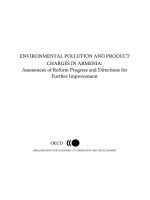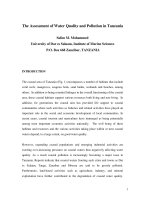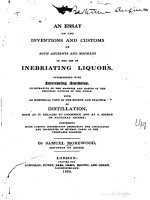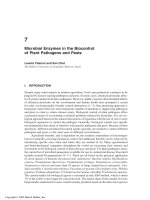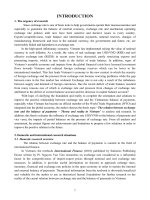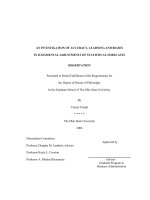Families Under Stress - An Assessment of Data, Theory, and Research on Marriage and Divorce in the Military pptx
Bạn đang xem bản rút gọn của tài liệu. Xem và tải ngay bản đầy đủ của tài liệu tại đây (1.09 MB, 246 trang )
This document and trademark(s) contained herein are protected by law
as indicated in a notice appearing later in this work. This electronic
representation of RAND intellectual property is provided for non-
commercial use only. Permission is required from RAND to reproduce, or
reuse in another form, any of our research documents.
Limited Electronic Distribution Rights
Visit RAND at www.rand.org
Explore RAND National Defense
Research Institute
View document details
For More Information
This PDF document was made available
from www.rand.org as a public service of
the RAND Corporation.
6
Jump down to document
THE ARTS
CHILD POLICY
CIVIL JUSTICE
EDUCATION
ENERGY AND ENVIRONMENT
HEALTH AND HEALTH CARE
INTERNATIONAL AFFAIRS
NATIONAL SECURITY
POPULATION AND AGING
PUBLIC SAFETY
SCIENCE AND TECHNOLOGY
SUBSTANCE ABUSE
TERRORISM AND
HOMELAND SECURITY
TRANSPORTATION AND
INFRASTRUCTURE
WORKFORCE AND WORKPLACE
The RAND Corporation is a nonprofit
research organization providing
objective analysis and effective
solutions that address the challenges
facing the public and private sectors
around the world.
Purchase this document
Browse Books & Publications
Make a charitable contribution
Support RAND
This product is part of the RAND Corporation monograph series.
RAND monographs present major research findings that address the
challenges facing the public and private sectors. All RAND mono-
graphs undergo rigorous peer review to ensure high standards for
research quality and objectivity.
Benjamin R. Karney, John S. Crown
Prepared for the Office of the Secretary of Defense
Approved for public release; distribution unlimited
Families Under Stress
An Assessment of Data, Theory, and
Research on Marriage and Divorce
in the Military
The RAND Corporation is a nonprofit research organization providing
objective analysis and effective solutions that address the challenges
facing the public and private sectors around the world. RAND’s
publications do not necessarily reflect the opinions of its research clients
and sponsors.
R
®
is a registered trademark.
© Copyright 2007 RAND Corporation
All rights reserved. No part of this book may be reproduced in any
form by any electronic or mechanical means (including photocopying,
recording, or information storage and retrieval) without permission in
writing from RAND.
Published 2007 by the RAND Corporation
1776 Main Street, P.O. Box 2138, Santa Monica, CA 90407-2138
1200 South Hayes Street, Arlington, VA 22202-5050
4570 Fifth Avenue, Suite 600, Pittsburgh, PA 15213-2665
RAND URL: />To order RAND documents or to obtain additional information, contact
Distribution Services: Telephone: (310) 451-7002;
Fax: (310) 451-6915; Email:
The research described in this report was prepared for the Office of the
Secretary of Defense (OSD). The research was conducted in the RAND
National Defense Research Institute, a federally funded research and
development center sponsored by the OSD, the Joint Staff, the Unified
Combatant Commands, the Department of the Navy, the Marine
Corps, the defense agencies, and the defense Intelligence Community
under Contract DASW01-01-C-0004.
Library of Congress Cataloging-in-Publication Data
Karney, Benjamin R.
Families under stress : an assessment of data, theory, and research on marriage and
divorce in the military / Benjamin R. Karney, John S. Crown.
p. cm.
Includes bibliographical references.
ISBN-13: 978-0-8330-4145-6 (pbk. : alk. paper)
1. Military spouses—United States. 2. Soldiers—Family relationships—United
States. 3. Divorce—United States. I. Crown, John S. II. Title. III. Title: Assessment
of data, theory, and research on marriage and divorce in the military.
UB403.K36 2007
306.8088'35500973—dc22
2007011014
iii
Preface
Since the onset of the military operations in Afghanistan and Iraq,
the demands on the military have been higher than they have been at
any time since the Vietnam War. In particular, deployments, especially
for the Army and the Marine Corps, have been longer, more frequent,
and more dangerous than they have been in the past. In the summer
and fall of 2005, briefings delivered to Dr. David Chu, Undersecre-
tary of Defense for Personnel and Readiness, raised concerns that these
lengthy separations were leading to rising divorce rates among military
families. ose concerns, in turn, raised broader questions about the
effects of military service on military marriages and about the most
effective ways of addressing the needs of military families.
e overarching goal of the research and analyses described in
this monograph is to provide an empirical and theoretical foundation
for discussions of these issues. In pursuit of this goal, we ask three ques-
tions. First, what has the accumulated research and theory on military
marriages contributed to an understanding of how and why military
marriages succeed or fail? To address this question, we reviewed the
existing theoretical and empirical literature on military marriage, iden-
tifying the strengths and limitations of this literature for understand-
ing the effects of deployment on marriages in the current environment.
Second, how have rates of transition into and out of marriage within
the military changed since the onset of the global war on terror? To
address this question, we drew on the last ten years of service personnel
records (i.e., five years before and after the attacks of 2001) to estimate
trends in marriage and marital dissolution for the active and reserve
iv Families Under Stress
components. ird, how does the length of time deployed affect the
likelihood that a married service member will subsequently end his
or her marriage? To address this question, we linked service record
data to data on individual deployments to Afghanistan and Iraq. e
monograph concludes by identifying priorities for future research on
these issues.
e analyses described in this monograph are meant to be under-
stood and used by a wide audience. us, the monograph may be of
interest to the military services, the Office of the Secretary of Defense,
individual service members and their families, members of Congress
and their staff, and the media. It may also interest foreign militaries
that have converted to a volunteer system and that want to be informed
about the effects of a high operating tempo on military families.
is research was sponsored by the Office of the Under Secre-
tary of Defense for Personnel and Readiness and conducted within the
Forces and Resources Policy Center of the RAND National Defense
Research Institute, a federally funded research and development center
sponsored by the Office of the Secretary of Defense, the Joint Staff,
the Unified Combatant Commands, the Department of the Navy,
the Marine Corps, the defense agencies, and the defense Intelligence
Community.
For more information on this research, contact Benjamin Karney,
who can be reached at For more infor-
mation on the RAND National Defense Research Institute, contact the
director, James Hosek. He can be reached by email at James_Hosek@
rand.org; by phone at 310-393-0411, extension 7183; or by mail
at the RAND Corporation, 1776 Main Street, Santa Monica,
California 90407-2138. More information about RAND is available at
www.rand.org.
Contents
v
Preface iii
Figures
xi
Tables
xv
Summary
xvii
Acknowledgments
xxxv
Abbreviations
xxxvii
CHAPTER ONE
Introduction 1
e Implications of Marriage for the Military
2
e Implications of the Military for Marriage
4
e Stress Hypothesis
4
e Selection Hypothesis
5
Overview of the Monograph
7
CHAPTER TWO
Developing Models of Military Marriage 9
Marital Outcomes: Distinguishing Between Dissolution and
Satisfaction
11
Marital Dissolution: Forming and Ending Marriages
12
Marital Satisfaction: Maintaining Marriages
14
Significance of Marital Satisfaction 14
Perspectives on Marital Satisfaction 15
Integrative Models of Civilian Marriage
18
vi Families Under Stress
Key Elements for Models of Success and Failure in Military
Marriages
19
Enduring Traits 19
Emergent Traits 21
Relationship Resources 22
e Military Context 23
Nonmilitary Circumstances 24
Adaptive Processes 24
Barriers and Alternatives
25
An Integrative Framework to Account for the Success and Failure of
Military Marriages
27
CHAPTER THREE
Review of Empirical Research on Military Marriages 33
e Scope of is Review
35
Limitations of the Existing Literature: On Methods for Studying
Military Marriages
36
Reliance on Self-Report Data
36
Reliance on Cross-Sectional Data
37
Reliance on Data from Individuals
37
Unwarranted Assumption of Homogeneity
38
Infrequent Acknowledgment of Cohort Effects
38
Lack of Model Testing
39
Enduring Traits and Characteristics
40
Emergent Traits
41
Relationship Resources
43
Military Experiences
46
e Selection Hypothesis: Does the Military Promote Premature
Marriage?
47
e Sequence and Timing Hypothesis: Does Military Service
Disrupt the Life Course?
49
e Stress Hypothesis: Do the Demands of Military Service Damage
Marriages?
50
e Trauma Hypothesis: Does Military Service Create Less-Fit
Spouses?
54
e Benefits of Military Service for Marriage
57
Nonmilitary Circumstances 58
Financial Stress and Spouse Employment
58
Housing
59
Access to Services
60
Separation from Friends and Family
61
Discussion
61
Adaptive Processes
62
Barriers and Alternatives
64
Summary and Conclusions
65
CHAPTER FOUR
Trends in Marriage and Divorce: Reanalyzing Military Service
Personnel Records
69
Problems in Existing Data on Marriage and Divorce in the Military
69
Overview of Trend Analyses
72
Methods
73
e Data Set
73
Defining Marital Status Categories
74
Patterns and Trends in Marriage Within the Active Component
75
Percentage Married
75
Marital Status upon Accession
78
Rates of First Marriage While in the Service
82
Discussion: Marriage in the Active Military
87
Patterns and Trends in Marital Dissolution Within the Active
Component
90
Rates of Marital Dissolution
90
Dissolution in Dual-Military Marriages
96
Discussion: Marital Dissolution in the Active Component
100
Patterns and Trends in Marriage and Marital Dissolution Within
the Coast Guard
103
Percentage Currently Married
104
Marital Status upon Accession
104
Rates of First Marriage While in the Service
105
Marital Dissolution
106
Discussion
108
Contents vii
Patterns and Trends in Marriage and Marital Dissolution Within
the Reserve Component
108
Percentage Married
109
Rates of First Marriage While in the Service
113
Rates of Marital Dissolution
117
Discussion: Marriage and Marital Dissolution in the Reserve
Component
122
Patterns and Trends in Marriage and Marital Dissolution Within
the National Guard
123
Percentage Married
123
Rates of First Marriage While in the Service
125
Rates of Marital Dissolution
128
Discussion: Marriage and Marital Dissolution in the National
Guard
131
CHAPTER FIVE
Evaluating Alternative Explanations for Rising Rates of Marital
Dissolution in the Military
133
Hypothesis No. 1: Coding Errors in the DMDC Database
134
Hypothesis No. 2: Policy Changes Affecting Active Army Officers
136
Hypothesis No. 3: Changes in Health Insurance Policy in 2002
137
Hypothesis No. 4: Demographic Changes in Response to the
reat of Deployment
140
Conclusion
145
CHAPTER SIX
e Direct Effects of Deployments on Marital Dissolution 147
Methodological Issues
147
Modeling Deployment Effects
149
Deployment Effects in the Active Component
150
Deployment Effects in the Reserve Component
153
Deployment Effects in the National Guard
155
Discussion of Deployment Effects
157
viii Families Under Stress
CHAPTER SEVEN
Conclusions and Future Directions for Research and Policy 161
Summary
162
General Discussion
165
Priorities for Future Research on Military Marriages
167
Implications for Supporting Military Marriages
172
APPENDIX
Marriage and Marital Dissolution Tables 177
References
189
Contents ix
Figures
xi
S.1. An Integrative Framework to Account for Success and
Failure in Military Marriages
xxvi
2.1. An Integrative Framework to Account for Success and
Failure in Military Marriages
28
4.1. Percentage Married Across All Active Services
76
4.2. Percentage Married in the Active Army
76
4.3. Percentage Married in the Active Navy
77
4.4. Percentage Married in the Active Air Force
77
4.5. Percentage Married in the Active Marine Corps
78
4.6. Percentage Married upon Accession Across All Active
Services
79
4.7. Percentage Married upon Accession, Active Enlisted
Women
80
4.8. Percentage Married upon Accession, Active Enlisted
Men
81
4.9. Percentage Married upon Accession, Active Female
Officers
81
4.10. Percentage Married upon Accession, Active Male
Officers
82
4.11. Percentage Entering First Marriage Across All Active
Services
83
4.12. Percentage Entering First Marriage in the Active Army
84
4.13. Percentage Entering First Marriage in the Active Navy
85
4.14. Percentage Entering First Marriage in the Active
Air Force
85
4.15. Percentage Entering First Marriage in the Active
Marine Corps
86
xii Families Under Stress
4.16. Rates of Marital Dissolution Across All Active Services 91
4.17. Rates of Marital Dissolution by Gender and Rank Across
All Active Services
92
4.18. Rates of Marital Dissolution in the Active Army
93
4.19. Rates of Marital Dissolution in the Active Navy
93
4.20. Rates of Marital Dissolution in the Active Air Force
94
4.21. Rates of Marital Dissolution in the Active Marine Corps
94
4.22. Rates of Dual-Military Marriage Across the Active Services
97
4.23. Rates of Marital Dissolution in Dual-Military Marriages
and Marriages to Civilians, Active Enlisted
98
4.24. Rates of Marital Dissolution in Dual-Military Marriages
and Marriages to Civilians, Active Officers
99
4.25. Comparing Rates of Marriage and Marital Dissolution
in the Active Military
101
4.26. Percentage Married in the Coast Guard
104
4.27. Percentage Married upon Accession in the Coast Guard
105
4.28. Percentage Entering First Marriage in the Coast Guard
107
4.29. Rates of Marital Dissolution in the Coast Guard
107
4.30. Percentage Married Across All Reserve Component
Services
110
4.31. Percentage Married in the Army Reserve
111
4.32. Percentage Married in the Navy Reserve
111
4.33. Percentage Married in the Air Force Reserve
112
4.34. Percentage Married in the Marine Corps Reserve
112
4.35. Percentage Entering First Marriage in the Reserve
Component
113
4.36. Percentage Entering First Marriage in the Army Reserve
114
4.37. Percentage Entering First Marriage in the Navy Reserve
115
4.38. Percentage Entering First Marriage in the Air Force
Reserve
115
4.39. Percentage Entering First Marriage in the Marine Corps
Reserve
116
4.40. Rate of Marital Dissolution Across All Services of the
Reserve Component
118
4.41. Rates of Marital Dissolution in the Army Reserve
119
4.42. Rates of Marital Dissolution in the Navy Reserve
119
4.43. Rates of Marital Dissolution in the Air Force Reserve
120
4.44. Rates of Marital Dissolution in the Marine Corps Reserve
120
4.45. Percentage Married Across All National Guard Services
124
Figures xiii
4.46. Percentage Married in the Army National Guard 124
4.47. Percentage Married in the Air National Guard
125
4.48. Percentage Entering First Marriage in the National
Guard
126
4.49. Percentage Entering First Marriage in the Army National
Guard
127
4.50. Percentage Entering First Marriage in the Air National
Guard
127
4.51. Rates of Marital Dissolution Across All Services of the
National Guard
128
4.52. Rates of Marital Dissolution in the Army National
Guard
129
4.53. Rates of Marital Dissolution in the Air National Guard
130
5.1. Rates of Dual-Military Marriage Across the Active
Services
138
5.2. Percentage Married Across All Active Services
139
5.3. Rates of Marital Dissolution in Dual-Military Marriages
Among Active Enlisted Service Members
139
5.4. Rates of Marital Dissolution in Dual-Military Marriages
Among Active Officers
140
5.5. Age of Active Army Members, 1996–2005
142
5.6. Age of Married Active Army Members, 1996–2005
142
5.7. Age of Married Active Navy Members, 1996–2005
143
5.8. Age of ose in the Active Army Entering Marriage
for the First Time, 1996–2005
144
Tables
xv
6.1. Survival Analysis Results for the Active Component 151
6.2. Survival Analysis Results for the Reserve Component
154
6.3. Survival Analysis Results for the National Guard
Component
156
A.1. Percentage Married in the Active Military
178
A.2. Percentage Married upon Accession in the Active
Military
179
A.3. Rates of Entering First Marriage in the Active Military
180
A.4. Rates of Marital Dissolution in the Active Military
181
A.5. Percentage Married in the Military Reserves
182
A.6. Rates of Entering First Marriage in the Military Reserves
183
A.7.
Rates of Marital Dissolution in the Military Reserves
184
A.8. Percentage Married in the National Guard
185
A.9. Rates of Entering First Marriage in the National Guard
186
A.10. Rates of Marital Dissolution in the National Guard
187
xvii
Summary
Since the initiation of military operations in Afghanistan and Iraq,
demands on service members are higher than they have been in several
decades. Deployments have been more widespread, longer, and more
frequent, a higher proportion of deployed service members have been
exposed to combat, and casualty rates are higher than at any other time
since Vietnam.
e sustained high tempo of current operations has raised con-
cerns about the effects that these demands may be having on service
members and their families. In particular, reports in the press and else-
where have suggested that the extended deployments leave military
marriages vulnerable to divorce. In a recent example, the New York
Times stated on its front page that “Military deployments have a way
of chewing up marriages, turning daily life upside down and making
strangers out of husbands and wives” (Alvarez, July 8, 2006). In surveys
and qualitative studies, spouses of service members strongly endorse
this view, describing their belief that the demands of military service,
and deployments in particular, lead to divorce. e assumption behind
such statements is that the stresses associated with lengthy deployments
(e.g., financial difficulties, anxiety about loved ones in combat, chal-
lenges communicating) interfere with spouses’ efforts to maintain their
relationships, damaging marriages that would have remained satisfying
and fulfilling in the absence of military stress. From this premise, it fol-
lows that divorce rates among military marriages should rise whenever
the demands on the military increase. roughout this monograph, we
refer to this idea as the stress hypothesis.
xviii Families Under Stress
Evaluating the effects of stress on military marriages is a key
issue for military leaders, for several reasons. First, the majority of ser-
vice members, both male and female, are married, and marriage rates
among service members exceed rates for comparable civilians. us,
trends that affect military marriages affect the majority of the armed
forces. Second, the weight of the existing evidence suggests that the
marriages of service members have direct effects on performance and
retention. us, trends that lead to the deterioration of military mar-
riages may have significant implications for national security. Devel-
oping effective policies and programs that support military families
requires accurate data on how these families have responded to the
demands of recent operations in Afghanistan and Iraq.
Goals and Approach of the Monograph
e overarching goal of this monograph is to inform discussions of the
current needs of military families by evaluating the existing empiri-
cal support for the stress hypothesis. We pursue this goal in two ways.
First, we review the prior research literature on military marriages,
focusing on research that has attempted to explain how military mar-
riages succeed and fail. Second, we examine data on transitions into
and out of marriage assembled from service personnel records, estimat-
ing trends over the past ten years and the direct effects of deployment
on subsequent risk of marital dissolution.
Prior Research on Stress and Military Marriage
No one disputes that military service is stressful for families, and
research drawing from surveys and focus groups has described these
stresses in detail. ese include “risk of injury or death, geographic
mobility, periodic separation of the service member from the rest of the
family, long working hours and shift work, residence in foreign coun-
tries, and normative pressures controlling behavior outside of working
time” (Segal, 1989, p. 7). A number of qualitative and survey studies
Summary xix
have examined the stresses associated with deployments in particular,
noting that each stage of the deployment cycle (notification and prepa-
ration, separation, and reunion) is associated with unique and severe
demands on military couples.
Yet despite the thoroughness with which the demands of mili-
tary service and deployment have been described, evidence that these
demands account for negative outcomes in military marriages remains
sparse. e strongest evidence in support of the stress hypothesis comes
from interviews and surveys of military spouses. When these spouses
are asked to describe their beliefs about the effects of military service
on their marriages, they suggest that the strains of military life hinder
their efforts to maintain their relationships (e.g., by minimizing oppor-
tunities for intimacy, by preventing effective problem-solving, by cre-
ating new problems to solve), thereby leading to negative outcomes in
marriages that might otherwise have avoided problems.
However, evidence that military stress actually accounts for prob-
lems in military marriages has been hard to come by. For example, two
independent analyses of data on Vietnam veterans (Call and Teach-
man, 1991 and Zax and Flueck, 2003) found that, controlling for age
at marriage, divorce rates for those who served during that war did
not differ from the rates for those who did not serve. And Bell and
Schumm (2000) commented:
Although the public associates deployments with high divorce
rates, there is no direct evidence that deployments cause
divorce. . . . Accordingly, any relationship between deployments
and subsequent divorce may be an artifact of self-selection or pre-
deployment conditions. (p. 146)
Estimating Trends in Marital Dissolution from Service
Personnel Records
Methodological limitations in prior research may have prevented an
adequate examination of the stress hypothesis. Surveys, for example,
rely on respondents who volunteer to participate, resulting in data
that may not generalize to the military as a whole. Moreover, because
xx Families Under Stress
the current demands on the military are unprecedented, results from
research on the military in prior decades may not hold true for the
military of today.
To overcome these limitations, we assembled and analyzed a new
data set describing transitions into and out of marriage among the
entire military population over the past ten years. Data on the marital
status of service members are contained in service personnel records.
Each service maintains these records in an idiosyncratic way, but the
services send monthly extracts of their records to the Defense Man-
power Data Center (DMDC), where the data are processed into forms
that can be analyzed. For this project, we asked DMDC to generate
quarterly summaries of the monthly extracts, beginning with the first
quarter of fiscal year (FY) 1996 and ending with the last quarter of
FY2005. Unlike the surveys that have informed most research on stress
and military marriage to date, these summaries include marital status
data on every person who has served in the United States Armed Forces
over the past decade, a population of over 6 million individuals.
To evaluate how trends in marital dissolution among military
couples may have changed since the onset of military operations in
Afghanistan and Iraq, we estimated the number of service members
who indicated a change of status from married to dissolved in each
fiscal year and divided it by the total number of married service mem-
bers at the start of that year. We estimated these dissolution rates sepa-
rately for each service in the active and reserve components, and sepa-
rately for each rank and gender within each service.
e stress hypothesis predicts that the beginning of the recent
military operations in FY2002 should coincide with a rise in rates of
marital dissolution and that rates of dissolution among military mar-
riages should have been higher in recent years, when demands on the
military were relatively high, than in the earlier part of the past decade,
when demands on the military were relatively low.
In fact, data from the past ten years of service personnel records
provide little support for either of these predictions. In the active com-
ponent, for example, rates of marital dissolution changed most abruptly
in the two years prior to FY2001. roughout the services and across
rank and gender, the change was the same: After peaking in FY1999,
Summary xxi
rates of dissolution fell sharply to a five-year low in FY2000. Since
FY2001, however, change in rates of marital dissolution has been more
gradual. In the Army, Air Force, and Marines, rates of marital disso-
lution indeed rose steadily from FY2001 to FY2005, but the effect of
this rise has been merely a return to rates similar to those observed in
FY1996, when the demands on the military were measurably lower
than in recent years. In the Navy, rates of marital dissolution increased
sharply in the first years after FY2001 but have declined in the last
two years. As with the other services, the Navy’s rates of dissolution in
FY2005 resembled those of FY1996. Trends in the reserve components
show a similar pattern. To summarize, service record data from the
past ten years do not demonstrate the high rates of marital dissolution
that are predicted by the stress hypothesis.
More-detailed analyses of these records highlight two noteworthy
patterns that hold true across all services and components. First, the
marriages of female service members are at several times higher risk
of dissolving than are the marriages of male service members. Female
service members are also far more likely to be married to other service
members (about 50 percent of women compared to less than 10 per-
cent of men), but this does not account for the difference in dissolution
rates. Second, the marriages of enlisted members are at higher risk than
are the marriages of officers. is is mostly likely due to the fact that
officers tend to be older, and age is positively associated with the likeli-
hood of a marriage remaining intact.
Estimating the Effects of Time Deployed on Subsequent
Risk of Marital Dissolution
ese trends reveal that, over a period when demands on the military
have increased markedly, rates of marital dissolution have increased
only gradually. Yet analyses of trends may be misleading because they
do not directly assess rates of marital dissolution among service mem-
bers whose marriages may be most at risk—i.e., those who have been
deployed to Afghanistan and Iraq. To address the effects of deployment
on marital dissolution, we drew upon longitudinal data to track the
xxii Families Under Stress
marital status of individual service members before, during, and after
their deployments while controlling for other demographic variables
likely to be associated with risk of marital dissolution (e.g., gender,
race, age at marriage).
For our analyses, we drew from the quarterly personnel summa-
ries provided by DMDC to create a longitudinal data set that linked
information from individual service members across quarters. is file
was then linked with a separate file provided by DMDC that con-
tained deployment histories for all service members deployed since
FY2002 when the current operations began. Although we could have
analyzed the data in terms of either incidence of deployment or cumu-
lative number of days deployed, we decided to examine the cumulative
days deployed, to account for possible differences between longer or
shorter deployments. To control for prior marital status, we conducted
analyses only on individuals who entered into marriages after the cur-
rent operations began. e result was a file containing data from 48
consecutive quarters that allowed us to map, from FY2002 through
FY2005, the timing and cumulative length of time spent deployed
against the timing of individual marriages and marital dissolutions.
We examined the new data set with multiple-spell discrete-
time survival analyses (see Willett and Singer, 1995). is approach
had several benefits. First, survival analyses account for the timing of
the dependent variable—that is, whether or not those service mem-
bers who were married during their deployments experienced a mari-
tal dissolution subsequent to their deployments. Second, the approach
allowed us to account for the cumulative effects of longer or shorter
periods of deployment. ird, it allowed us to ensure that individu-
als were matched on their marital duration in all analyses—i.e., that
the analyses evaluated risk of dissolution for individuals taking into
account how long they had been married. We ran separate analyses on
data from married enlisted members and married officers in each of the
services of the active and reserve components.
e stress hypothesis predicts that married service members who
are deployed will be at higher risk for dissolving their marriages when
they return, compared with married service members who are not
Summary xxiii
deployed. Moreover, the stress hypothesis suggests that longer deploy-
ments should be more damaging to marriages than shorter ones.
In fact, our analyses find support for the stress hypothesis only
among members of the active Air Force. In that service, among enlisted
members and officers, the more days that married service members
spent deployed, the greater their risk of dissolving their marriages after
they returned. In no other service could we observe the predicted effect
of time deployed on risk of dissolution. On the contrary, for enlisted
members in the active Army, Navy, and Marines, and for officers in the
active Navy and Marines, the longer that a service member is deployed
while married, the lower the subsequent risk of marital dissolution.
e same significant effect was observed among enlisted members and
officers in the Army Reserve, officers in the Navy Reserve, enlisted
members of the Air Force Reserve, and all ranks of the Army and Air
National Guard. In these groups, deployment appears to enhance the
stability of the marriage, and the longer the deployment, the greater
the benefit.
Understanding the Effects of Military Service and
Deployment on Military Marriages
Despite the demonstrable stresses associated with military service and
deployment and the widespread assumption that these stresses lead to
the deterioration of military marriages, our analyses revealed little sup-
port for the stress hypothesis. How can we explain the apparent dis-
junction between the data and popular belief? We offer several possible
explanations.
First, news reports of the drastic increase in military divorces may
have been based on data from the active Army in FY2004. During that
year, estimated rates of dissolution, reported to the Under Secretary of
Defense for Personnel and Readiness in 2005 and confirmed in this
monograph, were in fact disproportionately high for male and female
officers, so high that estimates for the Army as a whole appear elevated
for that year even though there were no comparable elevations among
enlisted members. However, dissolution rates among active Army offi-

